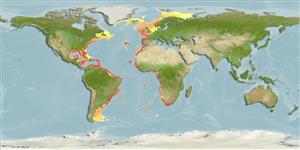Cephalopoda |
Oegopsida |
Enoploteuthidae
Environment: milieu / climate zone / djupintervall / distribution range
Ekologi
Pelagiska; djupintervall 1 - 1000 m (Ref. 110525). Tropical
Atlantic Ocean.
Length at first maturity / Size / Weight / Age
Könsmognad: Lm ? range ? - ? cm Max length : 2.8 cm ML hane/ej könsbestämd; (Ref. 104052); 3.3 cm ML (female)
Life cycle and mating behavior
Könsmognad | Reproduktion | Lek | Eggs | Fecundity | Larvae
Members of the class Cephalopoda are gonochoric. Male and female adults usually die shortly after spawning and brooding, respectively. Mating behavior: Males perform various displays to attract potential females for copulation. During copulation, male grasp the female and inserts the hectocotylus into the female's mantle cavity where fertilization usually occurs. Life cycle: Embryos hatch into planktonic stage and live for some time before they grow larger and take up a benthic existence as adults.
Nesis, K.N. 1987 Cephalopods of the world: squids, cuttlefishes, octopuses, and allies. T.F.H. Publications, New Jersey, USA. 351 pp. (Ref. 2399)
IUCN Red List Status
(Ref. 130435: Version 2025-1)
CITES status (Ref. 108899)
Not Evaluated
Not Evaluated
Threat to humans
Human uses
Fiskeri: saknar intresse
| FishSource |
Verktyg
Ytterligare information
Trophic EcologyFood items (preys)
Födosammansättning
Födointag
Predatorer
Population dynamicsTillväxt
Max. ages / sizes
Length-weight rel.
Length-length rel.
Length-frequencies
Mass conversion
Abundans
PhysiologySyreförbrukning
Human RelatedStamps, coins, misc.
Internet-källor
Estimates based on models
Fishing Vulnerability
Low vulnerability (10 of 100).
